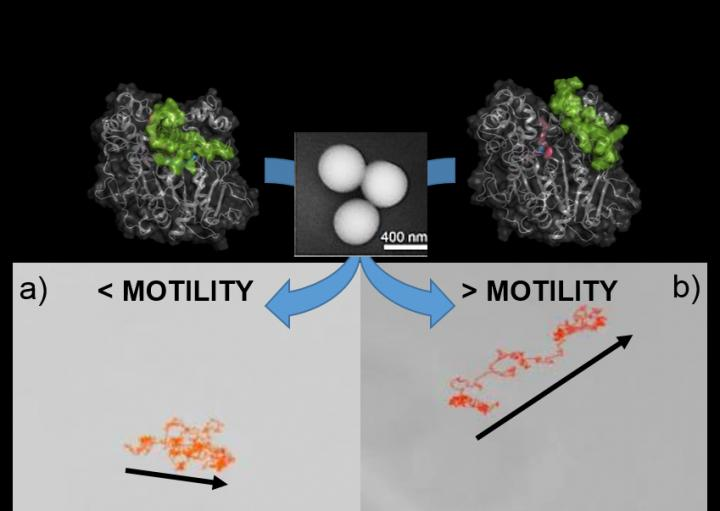Oct 14 2020
A new study has resolved one of the major barriers relating to the use of nanorobots driven by lipases—enzymes that play crucial roles in the digestion process by breaking down fats in foods to aid their absorption.
 (a) Trajectory of an enzyme-powered nanomotor prepared with lipase in a closed conformation and without controlled orientation during immobilization on the silicon nanoparticle surface. (b) Trajectory of an enzyme-powered nanomotor prepared with lipase in an open conformation and with controlled orientation during immobilization on the silicon nanoparticle Surface. The central panel shows a scanning electron microscopy image of nanomotors like those used in the experiment. Image Credit: Centro Nacional de Investigaciones Cardiovasculares (CNIC)/Institute for Bioengineering of Catalonia (IBEC).
(a) Trajectory of an enzyme-powered nanomotor prepared with lipase in a closed conformation and without controlled orientation during immobilization on the silicon nanoparticle surface. (b) Trajectory of an enzyme-powered nanomotor prepared with lipase in an open conformation and with controlled orientation during immobilization on the silicon nanoparticle Surface. The central panel shows a scanning electron microscopy image of nanomotors like those used in the experiment. Image Credit: Centro Nacional de Investigaciones Cardiovasculares (CNIC)/Institute for Bioengineering of Catalonia (IBEC).
The study was performed by a group of scientists from the Centro Nacional de Investigaciones Cardiovasculares (CNIC), the Universidad Complutense (UCM), Universidad de Girona (UdG), and the Institute for Bioengineering of Catalonia (IBEC) in association with other international centers.
The research work was supervised by Marco Filice from the CNIC Microscopy and Dynamic Imaging Unit—part of the ReDIB Infraestructura Científico Técnica Singular (ICTS)—professor at Pharmacy Faculty (UCM) and by Samuel Sánchez, an ICREA Research Professor from the IBEC.
Published in the Angewandte Chemie International Edition journal, the article explains a new tool for modulating motors driven by enzymes, extending their potential in environmental and biomedical applications.
Microbes have the ability to swim through complex surroundings, react to their environments, and arrange themselves independently. Taking a cue from these abilities, scientists have finally managed to artificially simulate these small swimmers after working on this for more than two decades. They did this first at the macro-micro scale and later at the nanoscale, identifying applications in biomedicine and environmental remediation.
The speed, load-bearing capacity, and ease of surface functionalization of micro and nanomotors have seen recent research advances convert these devices into promising instruments for solving many biomedical problems. However, a key challenge to the wider use of these nanorobots is choosing an appropriate motor to propel them.
Samuel Sánchez, ICREA Research Professor, Institute for Bioengineering of Catalonia
In the last five years, the IBEC team has been the first to demonstrate the use of enzymes to produce the propulsive force for nanomotors.
Bio-catalytic nanomotors use biological enzymes to convert chemical energy into mechanical force, and this approach has sparked great interest in the field, with urease, catalase, and glucose oxidase among the most frequent choices to power these tiny engines.
Samuel Sánchez, ICREA Research Professor, Institute for Bioengineering of Catalonia
The CNIC team is a frontrunner in the immobilization and structural manipulation of lipase enzymes found on the surface of varied nanomaterials.
Lipase enzymes make exceptional nanomotor components and this can be attributed to their catalytic mechanism that involves significant conformational variations between a closed and open active form.
“In this project, we investigated the effect of modulating the catalytic activity of lipase enzymes to propel silicon-based nanoparticles,” Filice explained.
Apart from the 3D conformation of the enzyme, the researchers also examined the regulation of the orientation of the enzyme during its immobilization on the surface of the nanomotor and its effect on the catalytic activity and thus on the propulsion of the nanorobots.
The team chemically altered the surface of silicon nanoparticles to create three particular combinations of lipase orientations and conformations at the time of immobilization—(1) closed conformation plus uncontrolled orientation, (2) open conformation plus controlled orientation, and (3) a condition intermediate between 1 and 2.
The researchers examined the three forms of nanorobot through spectroscopic methods, assays to evaluate the catalytic parameters associated with the activity of enzymes, dynamic molecular simulations (carried out by Professor Silvia Osuna’s group from UdG), and direct monitoring of separate nanomotor trajectories through microscopy methods.
The results demonstrate that combining an open enzyme conformation with a specific orientation on the nanomotor is critical to achieving controlled propulsion.
Study Researchers
Journal Reference:
Wang, L., et al. (2020) Enzyme Conformation Influences the Performance of Lipase-powered Nanomotors. Angewandte Chemie International Edition. doi.org/10.1002/ange.202008339.